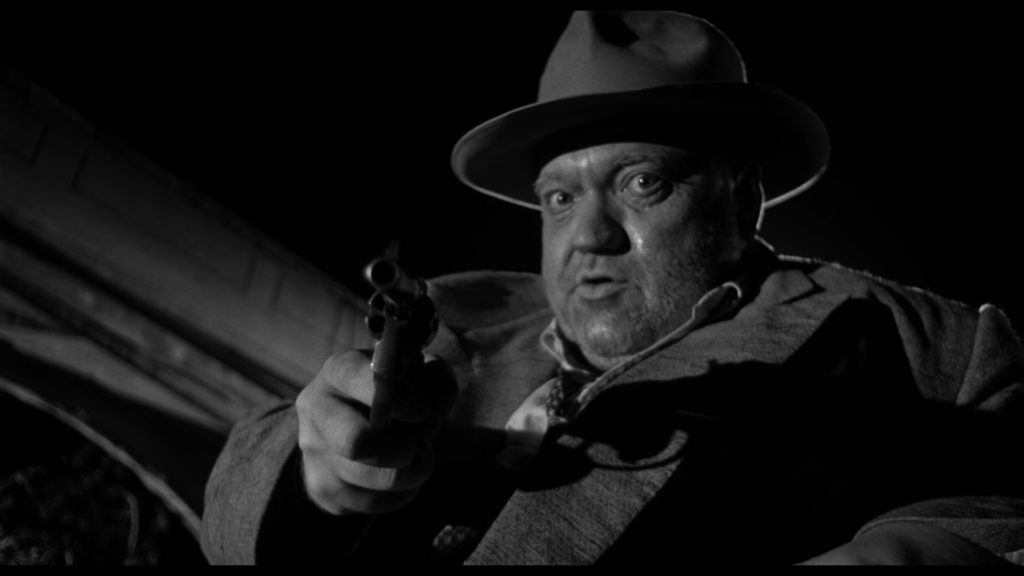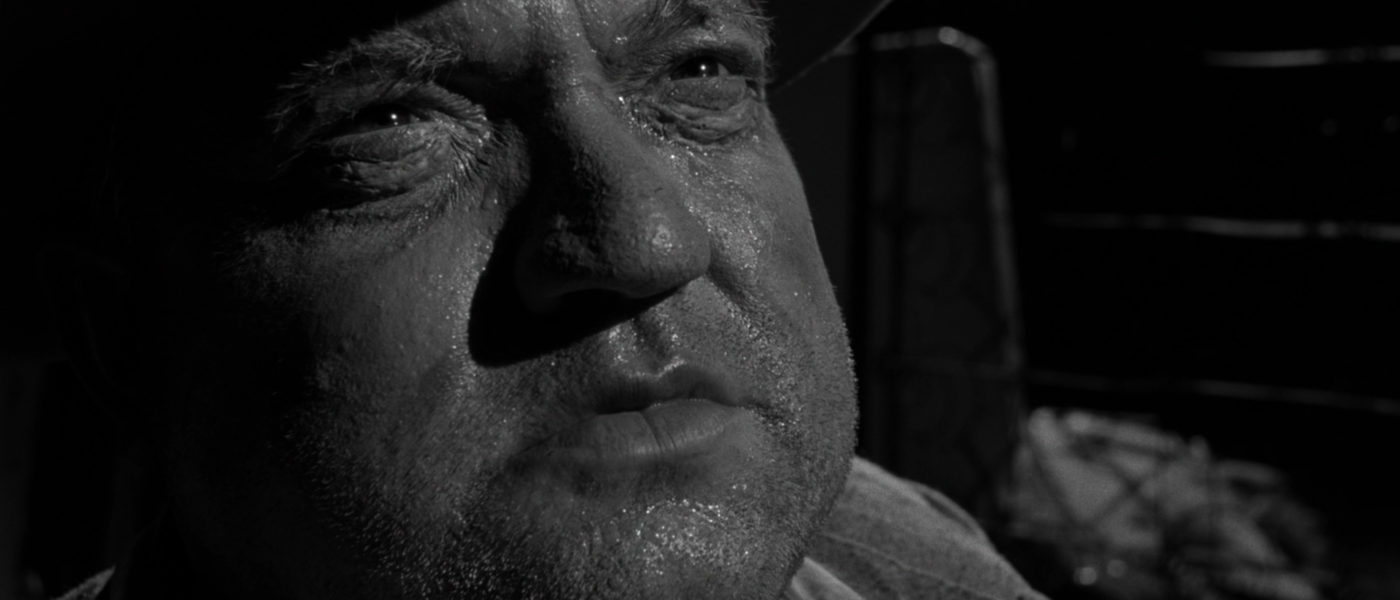Will Someone Please Help Janet Leigh Find A Decent Motel?
DIRECTED BY: ORSON WELLES/1958
STREET DATE: MARCH 15, 2022/KINO LORBER STUDIO CLASSICS
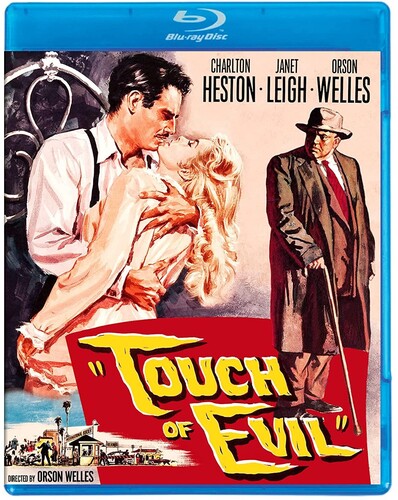
Orson Welles’ magnificent descent into the pulpy dregs of hypocrisy, desperation, and revenge – and that’s just in the editing room. The movie is as known for the director’s struggles to maintain any semblance of final control over his vision for the film as it is for its lionized status as the capstone, if not the epitaph written upon the capstone of the ‘40s-‘50s film noir cycle.
Touch of Evil was to be Welles’ grand return to Hollywood after his self-imposed exile to Europe, a move itself inspired by the post-production sins foisted upon his two 1940s films The Magnificent Ambersons and The Lady from Shanghai. So then, ten years after Shanghai, with all going smoothly on the Touch of Evil set, and with studio and helmer seeming to get along with relative and mutual hand-in-hand generosity, it was much to Orson’s surprise – or not – that he was locked out of his own first cut. He should’ve known better, and probably did, than to leave town for a talk show appearance with his film negative exposed and his Universal bosses within striking distance. When they surreptitiously screened his in-progress cut, they were horrified that their little genre B-picture had been dipped in grief and sweat and made to resemble nothing less than a squirming, black-hearted paean to the worst impulses of corrupt authority. Perhaps they merely saw box office shrinkage before their very eyes, or maybe they couldn’t understand the forward-thinking craftsmanship of Welles’ brilliant mise-en-scene (hand-held camera work, heavy location shooting, fast cutting, and zooms would become de rigueur for the French New Wave only two years later), or maybe… they saw a bit of themselves in the overreaching authority figures so damned by the narrative.
Whatever they saw, they took and wrangled it as best they could for their own purposes. Welles, remarkably given a chance to see their new cut, reacted to it by penning his now-legendary 58-page “memo” that outlined his thoughts on how they could construct a more sensible movie out of what they’d done. The memo is cordial, methodical, at times funny, and overwhelmingly astute about what makes a film work. The studio only applied a scant few of Welles’ suggestions, and the result – the “preview” version, as it was later called – was shown to audiences who were promptly confused by the cut-up plot and off-put by the dark humor and violence. Universal, spooked, flailed off another fifteen minutes, clipping it from 108 minutes down to 93. This version, now called the “theatrical” cut, is the one that audiences and critics knew for the next four decades. Yet even in its mangled form, the movie astounded many who knew what to appreciate about it, and it still became one of Welles’ established minor masterpieces.
Then, in the decade after his death, the famous, if ignored, memo inspired producer Rick Schmidlin to hire a ragtag gang of editors, film historians, and consultants to attack the 93-minute version and, using elements that still existed from the preview version and other found versions, build it back up into Welles’ memo-prescribed, wishful-thinking version. This 1998 “reconstruction”, based off of the memo, was supervised by no less than Walter Murch, an editor and sound designer who’d already won top-shelf honors and film nerd hero worship for his work on some of the greatest movies of his era: The Godfather films, The Conversation, American Graffiti, Apocalypse Now. It’s his and his team’s understanding of the nuanced relationship between sound and image, and their devotion to the holy writ that was the memo, that produced what is now the most definitive version of the film, the one closest to what can be called Welles’ vision that can ever be. Not a “director’s cut”, for the Welles memo only addresses the studio’s preview cut; the version that was gestating in that dark editing bay in mid-1957, under Welles’ own supervision, was lost for all time when the powers that be finally and forever took away “the best electric train set” the boy ever had.
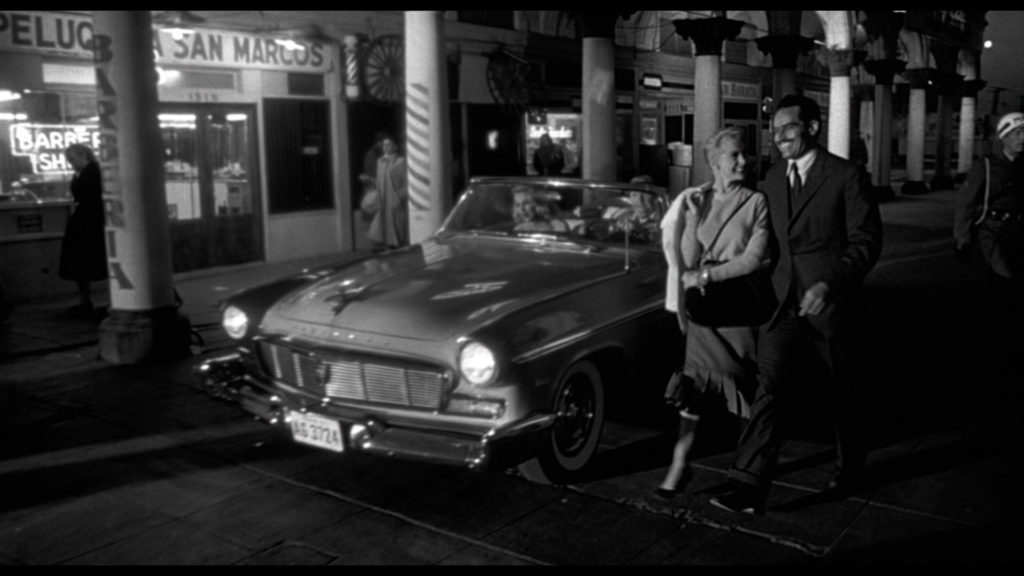
Kino Lorber’s new release contains the three prevalent cuts of the film, all of them released previously, as were many of the supplements – including commentary tracks across three discs by various contributors like film writer F.X. Feeney, Welles historians Jonathan Rosenbaum and James Naremore, and a delightfully anecdote-heavy track with producer Schmidlin alongside lead actors Charlton Heston and Janet Leigh. But this release smartly adds two brand new commentary tracks that reckon considerable heft to the discourse on the film’s troubled journey from hobbled studio conniption to gloriously restored, quasi-Welles cut. First is Kino Lorber regular Tim Lucas – his track is fixed to the 93-minute studio/theatrical cut – who provides his usual wry, levelheaded mix of facts and behind the scenes lore. Meanwhile, second, is smart and engaging Imogen Sara Smith, whose wonderfully dense and descriptive commentary track is tantamount to a feature-length video essay, expressing a deep dive into film history, production notes, and scene-specific interpretive analysis of the way the film breathes – or wheezes, more appropriately – its own enveloping sense of connection to the noirs that lead up to it, and to the even darker crime films that would follow it.
Smith’s commentary track, included on the reconstructed version, cites Welles’ confession to his biographer, the late filmmaker Peter Bogdanovich, that he always adhered to the classical Hollywood directorial approach of not showing off, that anything that called attention to itself is “the director’s failure”. Surely this is the subject in impish F for Fake mode, willfully ribbing his own DNA-level showmanship and glaring self-reflexivity. Certainly one of the greatest aspects of Touch of Evil is that it’s a movie that wants you to look at it. In any case, Welles famously does it all with incredible style, upgrading a B-movie into that which cannot be ignored for its visual power and its forever-resonating thematic punch so that, ultimately, any ancillary behind-the-scenes legend becomes mere wallpaper when confronted by the movie itself: Hank Quinlan (Welles) is a border town cop bloated by secrets swallowed, namely a string of framed suspects, but, as he swaggers in his defense, “nobody that wasn’t guilty.” Mike Vargas (Heston in awkward brownface) is a Mexican drug enforcement officer riding his career on the momentum of his perceived integrity. An American official and his mistress are killed on the American side when his car is exploded by a saboteur’s dynamite. Quinlan and Vargas are brought together in the firelight of that explosion, and together they play out the universal allegory of good and evil.
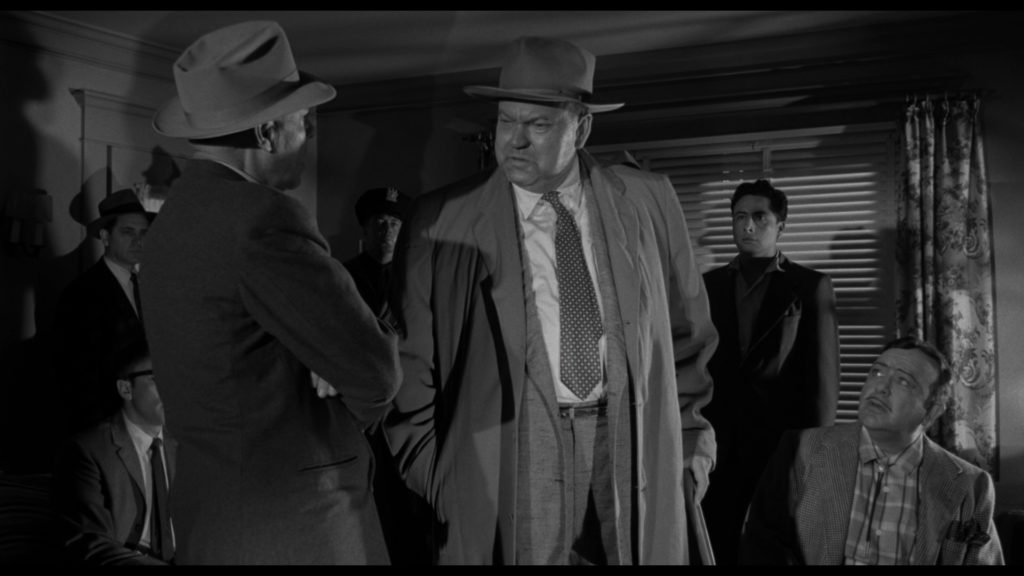
The first image of the movie, fingers twisting a timer on a homemade bomb, feels like someone winding up a toy and watching it go, a fun gambit rewarded by the famous, jazzily meandering opening tracking shot that ends with the inciting explosion. From there, Welles lowers his story into murder, sex, drugs, revenge, and regret and never brings it back up for air. It’s a claustrophobic world, stinking with death, where the liveliest moments come from a pianola played by no one; where a smug, lurid chuckle barely masks the condescension of institutionalized racism; where “intuition” is as good as justification; and where even the man for whom all the busy police work is set to avenge – the exploded official – is himself a brazen philanderer estranged from his family.
The drama bifurcates almost immediately as Vargas and his new American bride, Susan (Leigh) amble into their own journeys of disillusionment and shame. Vargas follows Quinlan around like a legal chaperone, miming some rock-jawed variation on truth and justice by way of Mexico City in the jowled face of Quinlan’s obvious frame job of a young Mexican man – Quinlan has planted two sticks of dynamite in the man’s bathroom, tying him to the official’s murder. Meanwhile, Quinlan’s ordered his goons to find and drug Susan at her seedy motel in hopes her forced high will bring Vargas’s reputation low. Watching over that motel is the “night man”, Dennis Weaver, manic and creepy in equal measure, like some proto-amalgam of Norman Bates and Hopper in Apocalypse. The unexplained extremes of his hyper-revulsion to all that’s set before him matches the opposite blasé neutrality that almost everyone else in the movie levels at the constant grime and dross – a cipher for the sins of Los Robles in one writhing vessel of freaked-out despair – and incredibly fun to watch. Weaver’s night man is part of a menagerie of characters that somehow reflects the turned-out guts of the demon slouched over the city, namely the not-so-avuncular Uncle Joe Grandi (Akim Tamiroff), part of a drug family that straddles the border, playing both sides, manifesting as a self-important devil on Quinlan’s shoulder, making deals with the cop who “never makes deals.” And across town is Tana, a settled-down gypsy flashing her Marlene Dietrich eyes, cutting the smoky air with her razor-sharp cheekbones, and providing the perhaps unwanted evidence of Quinlan’s former love life… and a great excuse to use chili as a euphemism for sex.
All of this near-comic, near-cartoony frill is mixed into the straightforward melodrama, but in Welles’ hands it’s all as corpulent and sweaty as Quinlan himself, so thoroughly shot through with dread and dirt, it renders even more disturbing the already blunt dialogue: “An hour ago he had this town in his pocket… Now you can strain him with a sieve”; “We don’t like it when innocent people are blown to jelly in our town.” And running underneath, seething racism, none of it entirely subtle. Susan, embarking toward the fateful motel: “I’m just going to an American motel for comfort…not for safety.” Quinlan to Vargas: “You people are touchy.” And Vargas’ own reverse racism, contained quietly in his observation that the idea of peace, in the form of a 1,400 mile border without a single machine gun in place, is “corny” to his American bride, as if to imply American hubris is uncomfortable with the idea of going warless for so long.
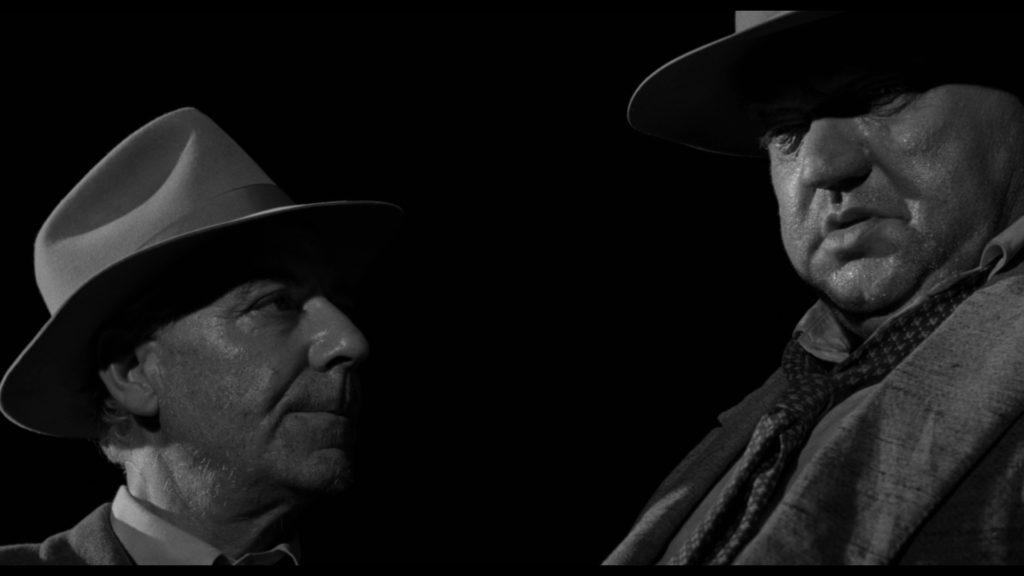
But the film is also stilted up by the themes of blind duty and crippling idealism. Quinlan, as few scruples as Falstaff, but none of the fun, orders his world of planted evidence upon the simple and good philosophy: “When a murderer’s loose, I’m supposed to catch him.” And this reasoned exchange with his dutiful partner Menzies (Joseph Calleia) in the final moments:
MENZIES: You’re a killer.
QUINLAN: I’m a cop…I don’t call my job dirty, look at the record. All those convictions.
MENZIES: Convictions, sure. How many did you frame?
QUINLAN: Nobody… nobody that wasn’t guilty.
MENZIES: …Faking evidence…
QUINLAN: Aiding justice, partner.
Evil there, but with good in the balance: the borderline self-righteousness of Vargas. The slow show of Quinlan’s dark deeds often stirs Vargas into sanctimonious diatribes. To Quinlan: “In any free country a policeman is supposed to enforce the law, and the law protects the guilty as well as the innocent… A policeman’s job is only easy in a police state. That’s the whole point, Captain. Who’s the boss, the cop or the law?” And to Menzies, laying it on thick: “What about all the people Quinlan put in the death house. Save your tears for them.” In fact, the greatest fault of the film is that it allows Vargas, the mouthpiece for glib, nickel-plated platitudes, to finally elude the moral griminess of the real world. Though he is touched by evil – or rather, it is Susan who is groped by evil, and he is only threatened by the possibility of being forever associated with evil, he is never fully in its grasp, never made to suffer the crush of evil, the kind of evil that creates the Quinlans of the world. He even makes his exit before Quinlan’s death plunge, falling into Susan’s exonerated arms, speeding away into marital bliss, so that he doesn’t have to personally bear witness to the final, bloody result of his revenge.
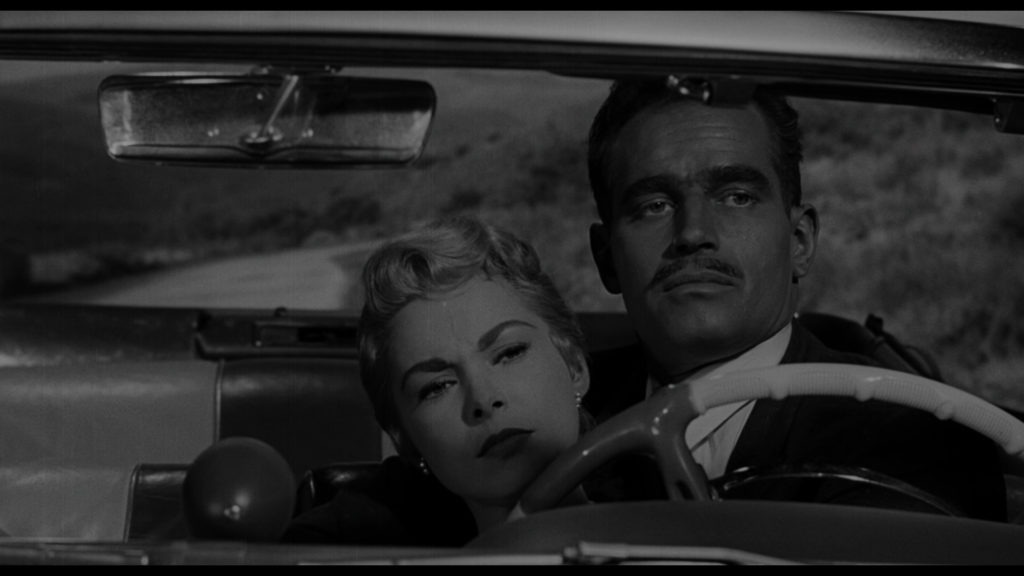
Vargas’s innate cowardice, underneath a sheen of screwed-up, do-gooder courage, is what allows him to push Menzies into the fray of Quinlan’s marauding, drunken, and oozing id in the final sequence. Menzies’ agreement to wear the wire tees up the necessary culmination of not only Vargas’s lack of true heroism in the film (he fidgets wildly on the subject of defending Sanchez) but also Menzies’ need to confront Quinlan’s exploitation of his loyalty face-to-face. Menzies, the only character to truly change by the end of the movie, is – in screenwriting terms – the de facto hero of the movie. He gets to shoot the bad guy, but only after he realizes his own culpability in a lifetime of criminal evil. It may be Vargas that provokes the evil in the film, but it’s truly Menzies who is touched by it, and then, tragically, destroyed by it – he is drawn into the centripetal force of Quinlan’s gothic implosion and killed by it, both swirling dead in a cesspool somewhere along the smudged border of two worlds.
Reconstruction editor Murch describes the miracle of this turn of events for Menzies by simply following Welles’ quick, seemingly-arbitrary note to remove a particular close-up of Menzies in the file-room conversation with Vargas. The close-up in question shows Menzies wilting under the pressure of Vargas’ accusations, thus setting up a conclusion animated by mere coercion of Menzies by Vargas to do the right thing. Minus the close-up, it becomes Menzies own conscience that compels him to act against the boss he’s worshiped for thirty years. Had the close-up remained, literally no one would have changed for the better in the entire picture – perhaps another stamp of the film’s bleak noir intentions… But Welles knew his dark anthem to disloyalty would not be complete without an enlightened stand against the deep root of corruption at the center of the story. Menzies provides that with much soul and poignancy.
An easily unrecognized thing happens when watching Touch of Evil in modern times. The somewhat tacked-on resolution of the Sanchez story is that he’s said to have ultimately confessed his guilt to Quinlan’s men. This is presumably meant to layer the end with irony, that all of Quinlan’s hunches were correct, and that planting all that evidence was, as he said, actually “aiding justice.” But a modern audience, in a post-enhanced-interrogation environment, is left with an even murkier ending, one that calls into question if the confession was under duress, one meant simply to abate the fists (which you can hear in the background on the soundtrack). It is wonderfully, terribly fascinating to consider that, even as often as art influences society, it’s also true that society can forever alter the meaning of art. And in this case, the mystery of meaning can make Touch of Evil, to use Welles’ own words, “just exactly a thousand percent more effective.”
The cumulative force of this Kino Lorber release, presenting the oldest and newest versions of the film, alongside old and new commentary, is a college course in the history and ongoing meaning of one of the greatest films made by one of America’s greatest filmmakers. In a letter to Heston, Welles said the studio was in a state of “decay and despair” when they opted to incorporate at least some of his memo notes. But he was naive still about the extents to which the “decaying and despairing” studio system would bend to a single artist’s vision, especially one as pocked by combat wounds as Welles. But as Smith says with understated gravitas in her commentary, “That he was able to make something this radical and personal in such an atmosphere of profit-driven timidity is quite amazing.” What can you say about a filmmaker but what’s said by their work. Maybe all you can do is co-opt Dietrich’s film-closing sentiment and say: it’s some kind of movie.
Kino Lorber has released the film in 4KUHD and Blu-ray with each version of the film a brand new 4K restoration. The images in this review are not representative of the actual discs’ image quality, and are included only to represent the film itself.
